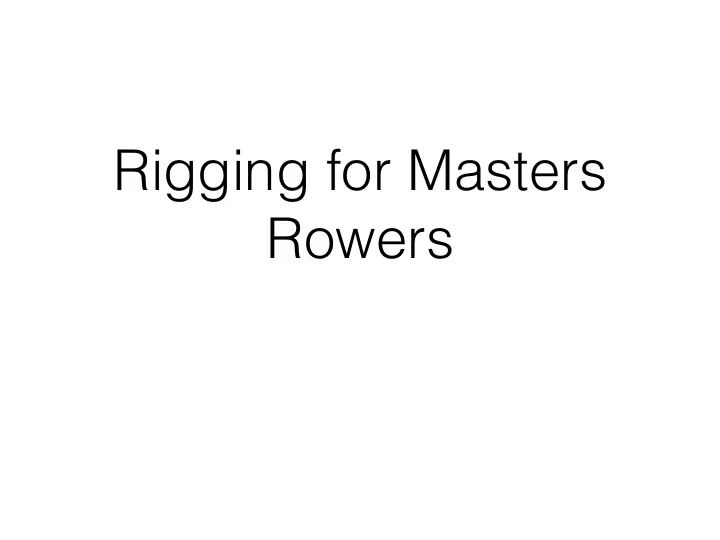

Rigging for Masters Rowers
What is rigging for? • Rigging is simply a tool we can use to maximise our technique • Why are we concerned with technique
Technique (& Rigging) • Efficiency • Injury free • Comfort • Effectiveness • Speed • Enjoyment
Nolte, V. 2011
Foundations Technique • Balance • Posture (grip) • Rowing movements Rigging • Large arc (catch angle) • Maximal force application (repeated) • Long time force application
Rigging has 2 “levels” 1. Introductory 2. Individualised
Starting point • What is available to you • Know your equipment • Goals (effort/time) • Self assessment
What/Why? Load • maximise • maintain Relevance to masters • Strength • Flexibility • Injury
How? • Experiment • With everything! • One thing at a time • Measure/change/test/compare “If you are not assessing you are guessing”
Load Factors • Stroke length • Arc placement • Leverage • Rhythm • Ratio (drive time) • Blade slip
Stroke Length • Simply the distance (at the tip of the blade) from catch to release • Time blade spends in water relative to load • All crew to have same stroke length
Length Difference
Arc Placement adjust span
Arc Placement adjust inboard
Arc Placement adjust span and inboard equally
Leverage (outboard)12)/(Span/2)1 Oar$length$ Inboard$ Outboard$ Span$ Load$Ratio$ 289$ 88$ 201$ 160$ 2.3625$ 287$ 88$ 199$ 160$ 2.3375$ 285$ 88$ 197$ 160$ 2.3125$ 289$ 87$ 202$ 159$ 2.3899$ 287$ 87$ 200$ 159$ 2.3648$ 285$ 87$ 198$ 159$ 2.3396$ 289$ 88$ 201$ 159$ 2.3774$ 287$ 88$ 199$ 159$ 2.3522$ 285$ 88$ 197$ 159$ 2.3270$ 289$ 87$ 202$ 160$ 2.3750$ 287$ 87$ 200$ 160$ 2.3500$ 285$ 87$ 198$ 160$ 2.3250$ !
Rhythm & Ratio Rhythm • Pattern of drive and recovery body movements in drive and recovery • Looking for a synchronized flow with gives athlete feeling of swing and sets up ability to apply effort Ratio • Recovery time to drive time…can be highly individual • Gives insight into desired rhythm
Blade Slip • Distance at tip of blade from entry to release • Can be positive or negative • Positive slip increases distance boat moves during drive • Seen when blade moves in same direction as boat during drive
Blade Slip
Blade Slip Neg slip 1. Short stroke arc 2. Smaller catch angle 3. Lighter rigging load Pos slip 1. Longer stroke arc 2. Larger catch angle and arc placement 3. Matching load with athlete’s power ability
Individual Shorter • Decrease inboard • Increase oar length • Increase catch angle • Decrease spread Taller • Increase inboard • Decrease oar length • Decrease catch angle • Decrease outboard • Increase spread
Happy Rigging! Supported by ViaSport Sources ‘Notes on Rowing’ - Mike Purcer ‘Rowing Faster 1st Edition’ -Volker Nolte ‘Sculling’ - Paul Thompson Row Perfect - Rigging angle changes due to adjusting span etc’
Recommend
More recommend